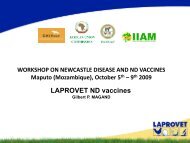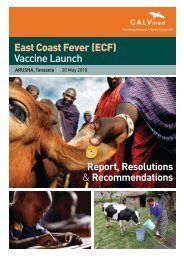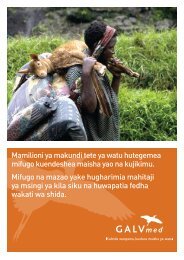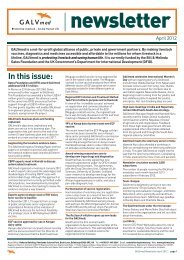A Path to Prosperity New Directions for African Livestock
GALVmed Impetus Strategy Paper
GALVmed Impetus Strategy Paper
- No tags were found...
Create successful ePaper yourself
Turn your PDF publications into a flip-book with our unique Google optimized e-Paper software.
6.2 Regional and Domestic<br />
Lives<strong>to</strong>ck Trade<br />
Most analysts agree that the best future market<br />
<strong>for</strong> <strong>African</strong> lives<strong>to</strong>ck lies within Africa itself.<br />
Africa’s meat demand is projected <strong>to</strong> increase,<br />
albeit more slowly than other developing regions.<br />
Rosegrant et al 117 predicted it would triple between<br />
1997 and 2025, from 5.5 <strong>to</strong> 13.3 million metric<br />
<strong>to</strong>nnes. Given relatively high income elasticities <strong>for</strong><br />
lives<strong>to</strong>ck products, this increase will likely be even<br />
greater if SSA is able <strong>to</strong> accelerate its economic<br />
growth in the future. Demand <strong>for</strong> dairy products<br />
and eggs is also high.<br />
In coming years, <strong>African</strong> urban markets will offer<br />
ever greater trade opportunities. They are<br />
substantially larger than export markets <strong>for</strong> most<br />
products and they are growing faster. Africa’s <strong>to</strong>tal<br />
urban market was estimated <strong>to</strong> be worth close <strong>to</strong><br />
US$17 billion <strong>for</strong> smallholder producers in 2002,<br />
compared with US$4 billion <strong>for</strong> agricultural export<br />
markets 118 . Demand <strong>for</strong> food, particularly meat,<br />
milk and eggs, is predicted <strong>to</strong> increase substantially<br />
as discretionary income is projected <strong>to</strong> rise by 50%<br />
over the next ten years 134 .<br />
Both CAADP and AU/IBAR development strategies<br />
include improvement of intra-regional and domestic<br />
lives<strong>to</strong>ck trade. These strategies make sense.<br />
To fully exploit the diversity and comparative<br />
advantages of ecosystems and production systems,<br />
<strong>African</strong> countries need <strong>to</strong> accelerate regional<br />
market integration. The development of regional<br />
markets could create the economies of scale<br />
needed <strong>to</strong> make higher levels of processing feasible<br />
and profitable. These might then promote exports<br />
<strong>to</strong> other regional and global markets.<br />
Currently, most countries maintain national trade<br />
policies that disregard regional diversity and<br />
utilisation of comparative advantage.<br />
6.2.1 Kenyan Beef Trade<br />
Kenya has a tariff-free quota <strong>to</strong> export beef <strong>to</strong> the<br />
EC, but is no longer able <strong>to</strong> meet this quota due <strong>to</strong><br />
high sanitary standards. Kenya instead exports<br />
some frozen beef <strong>to</strong> Gulf States who have less<br />
stringent disease regulations, but faces strong<br />
rivalry <strong>for</strong> these markets from established global<br />
exporters and its neighbours Ethiopia and Sudan.<br />
Kenya has managed <strong>to</strong> establish a profitable export<br />
trade in live cattle <strong>to</strong> Mauritius, but again faces stiff<br />
competition in this area from Ethiopia, Somalia and<br />
Sudan. The domestic market <strong>for</strong> beef looks like an<br />
attractive and reliable option <strong>for</strong> Kenyan producers.<br />
Domestic beef consumption levels are currently<br />
increasing at an annual rate of 2.75%. The bulk of<br />
this consumption occurs in the cities. Recent<br />
marketing studies estimate that Nairobi and<br />
Mombasa collectively consume about 850,000<br />
animals per annum. Over the next five years, the<br />
deficit between beef demand and beef production<br />
in Kenya is anticipated <strong>to</strong> grow by 3% per annum,<br />
an overall increase of 15.9% by 2014, despite<br />
population growth estimates being a more<br />
moderate 8.8% <strong>for</strong> the same period. The estimated<br />
production deficit will there<strong>for</strong>e be almost 50,000<br />
<strong>to</strong>nnes 119 . Novel ways of meeting this demand and<br />
accessing Gulf State markets are already being<br />
drawn up by the private sec<strong>to</strong>r within Kenya<br />
(see Box 7). It could be profitable <strong>for</strong> Kenya <strong>to</strong><br />
recognise that neighbouring states (Somalia,<br />
Ethiopia, Sudan and Tanzania) have traditionally<br />
met Kenya’s demand through in<strong>for</strong>mal cross-border<br />
movement of cattle. Formalising this trade could<br />
address domestic demand and perhaps gain<br />
consistent quality supplies <strong>for</strong> export markets.<br />
6.2.2 Sahel and West Africa (SWA) Trade<br />
Unlike East Africa and the Horn, West <strong>African</strong> States<br />
have made concerted ef<strong>for</strong>ts <strong>to</strong> take advantage<br />
of regional lives<strong>to</strong>ck movements, particularly<br />
ruminants from extensive pas<strong>to</strong>ral grazing areas.<br />
The main ruminant exporters are Burkina Faso,<br />
Mali and Niger, and the main importers are Côte<br />
d’Ivoire, Ghana and Nigeria. There are virtually no<br />
exports <strong>to</strong> countries outside the region.<br />
The Impetus Strategy Paper I Page 43











